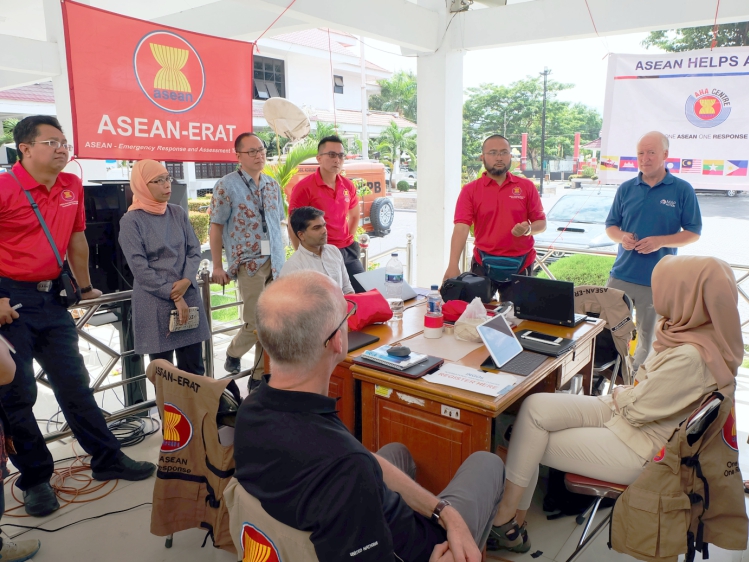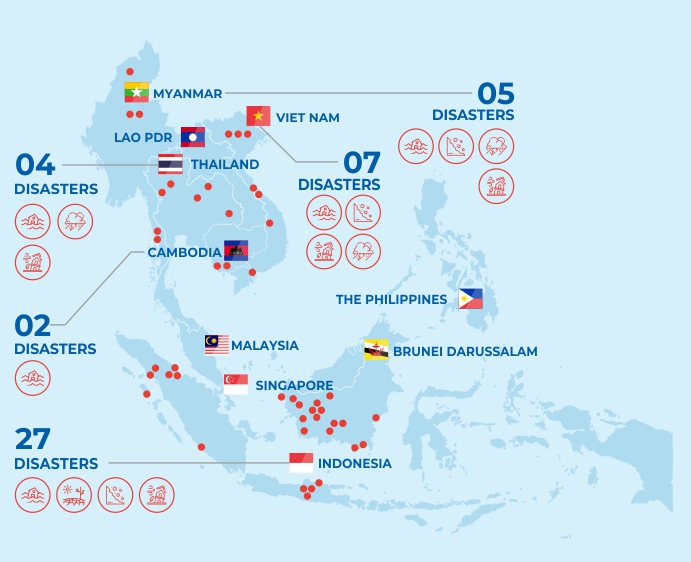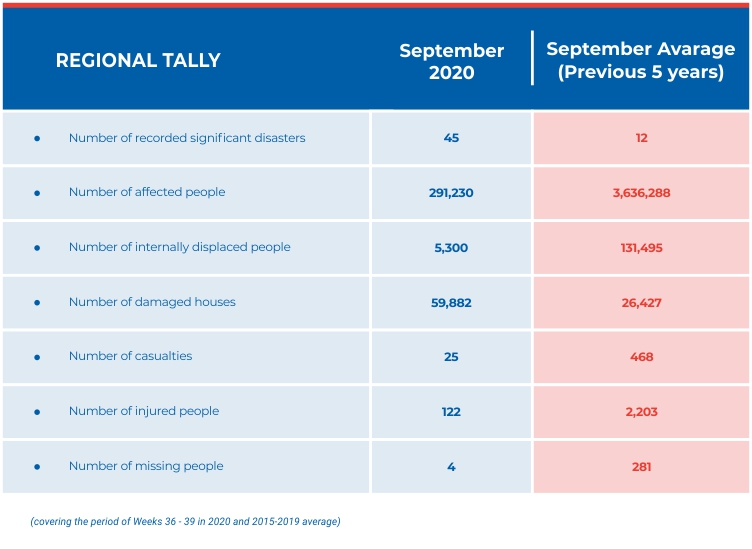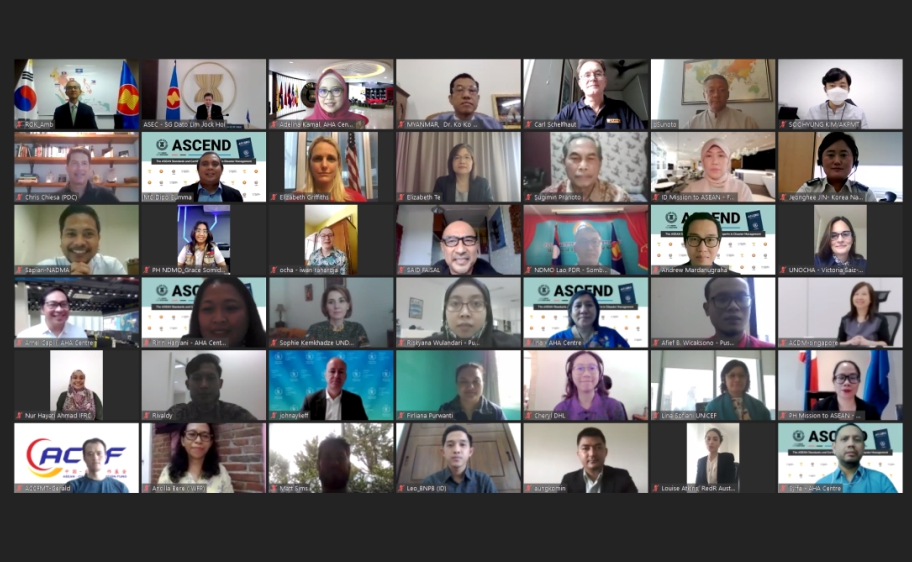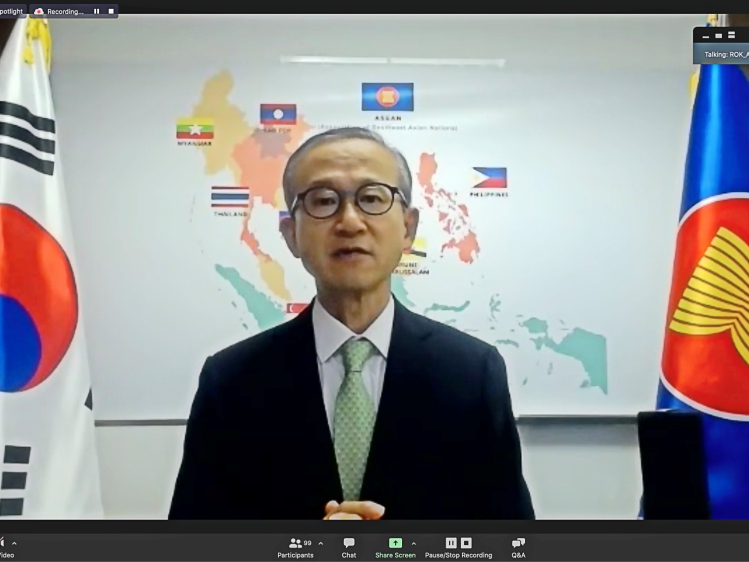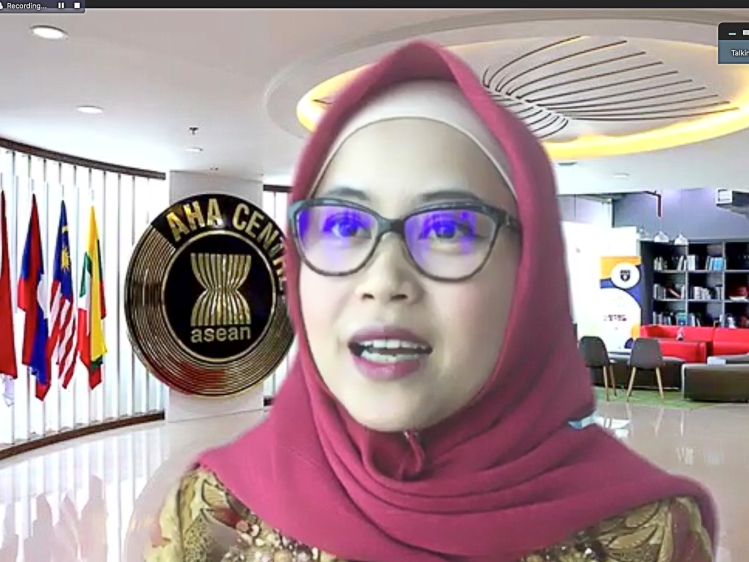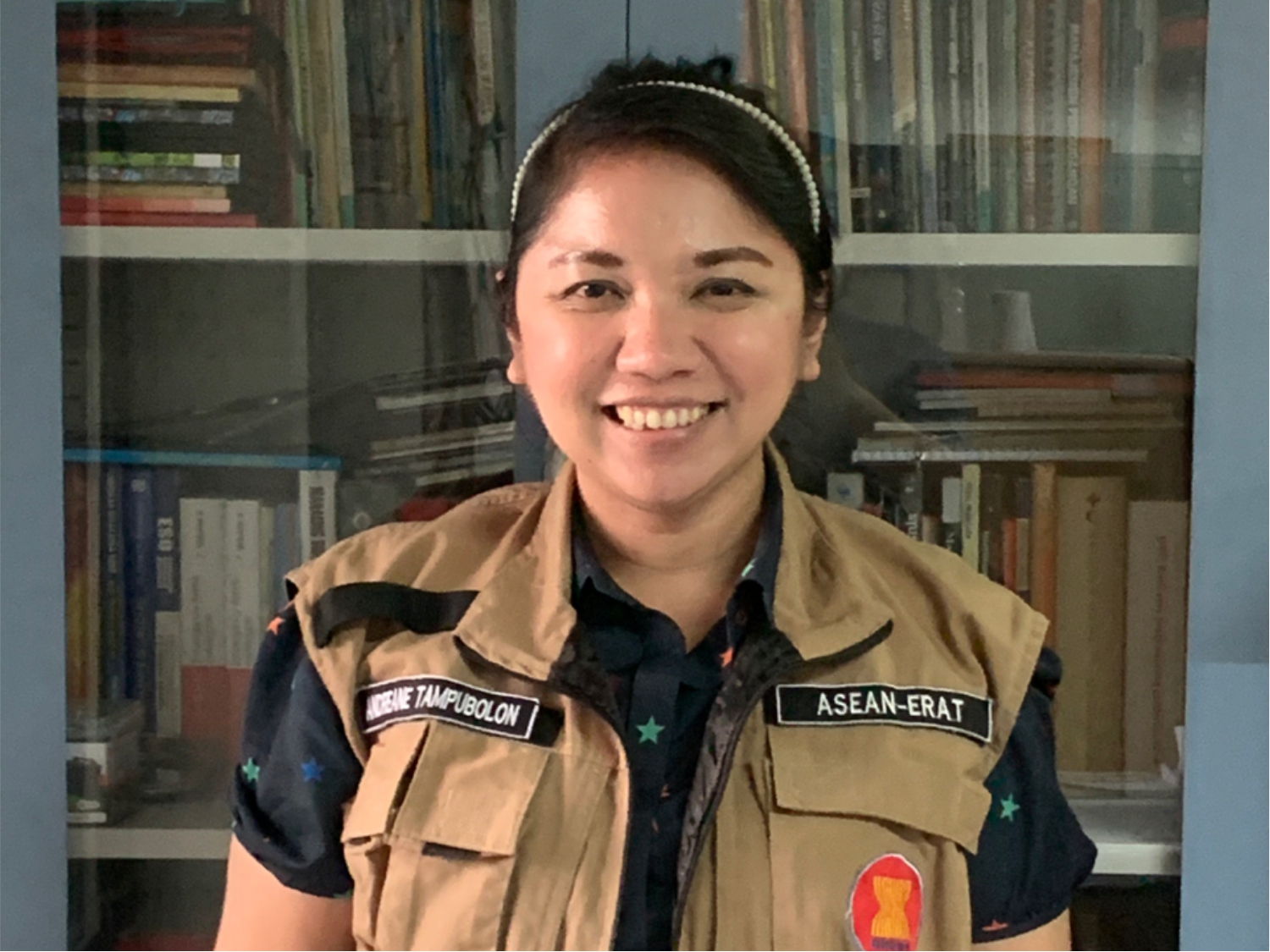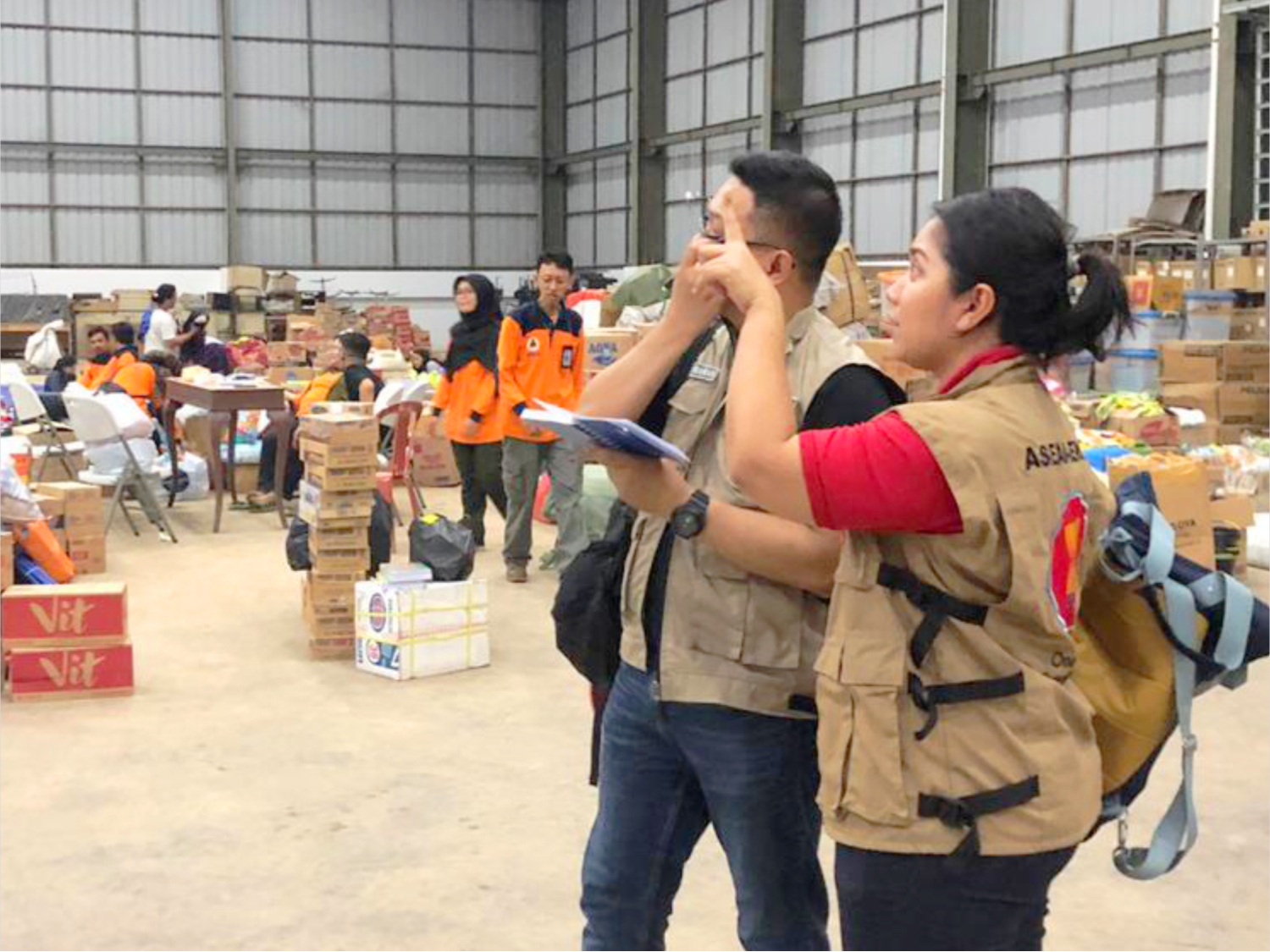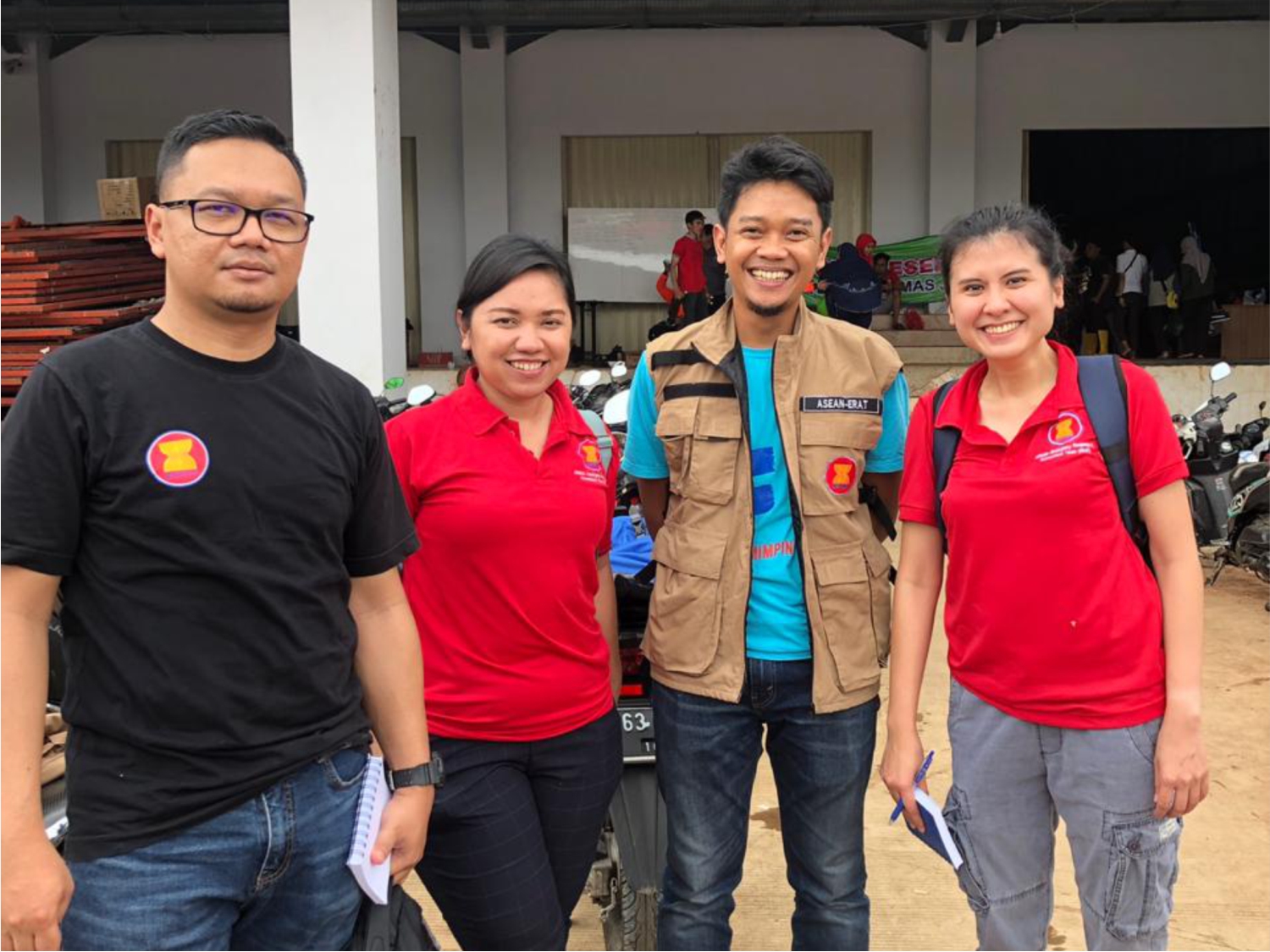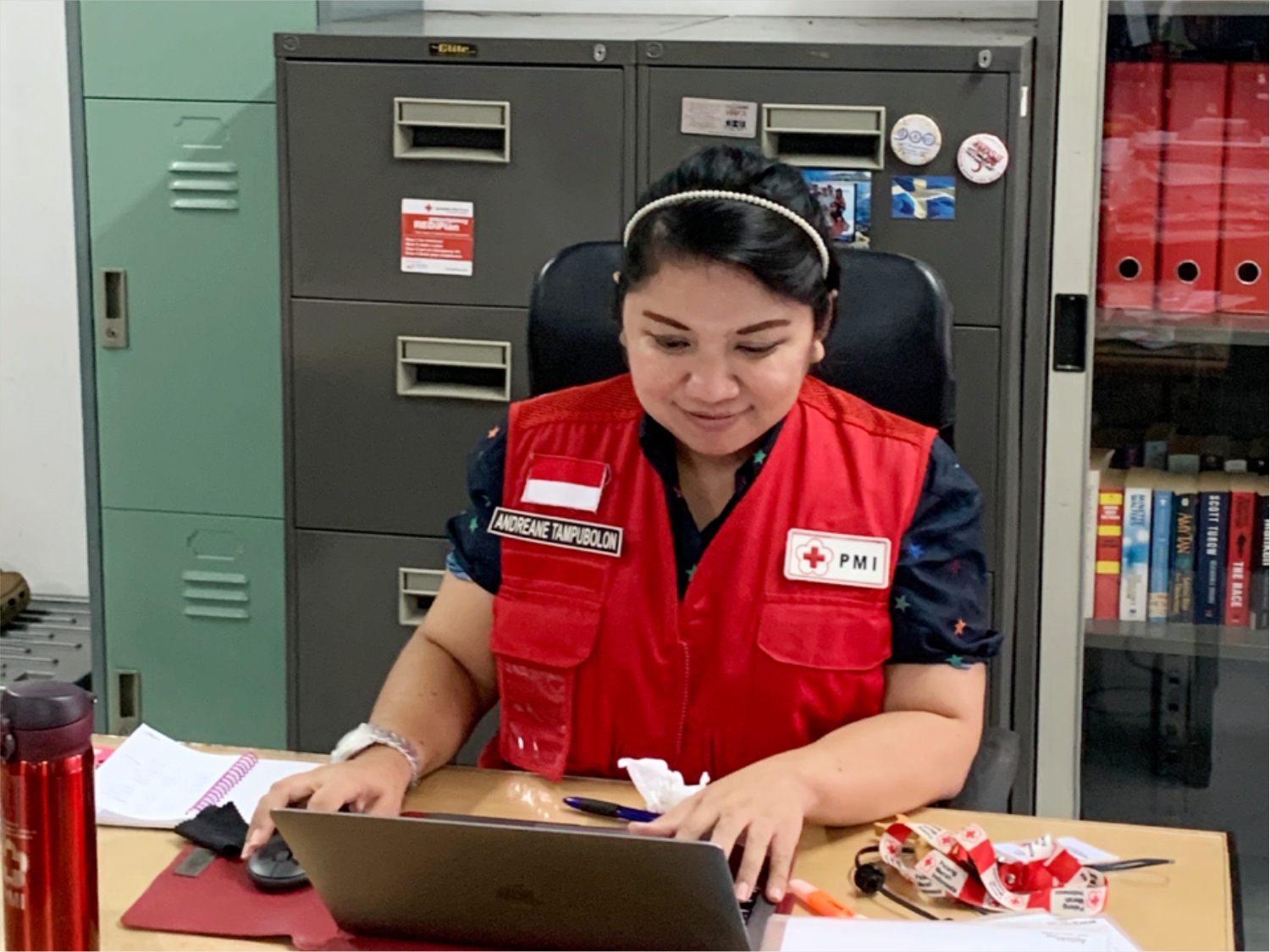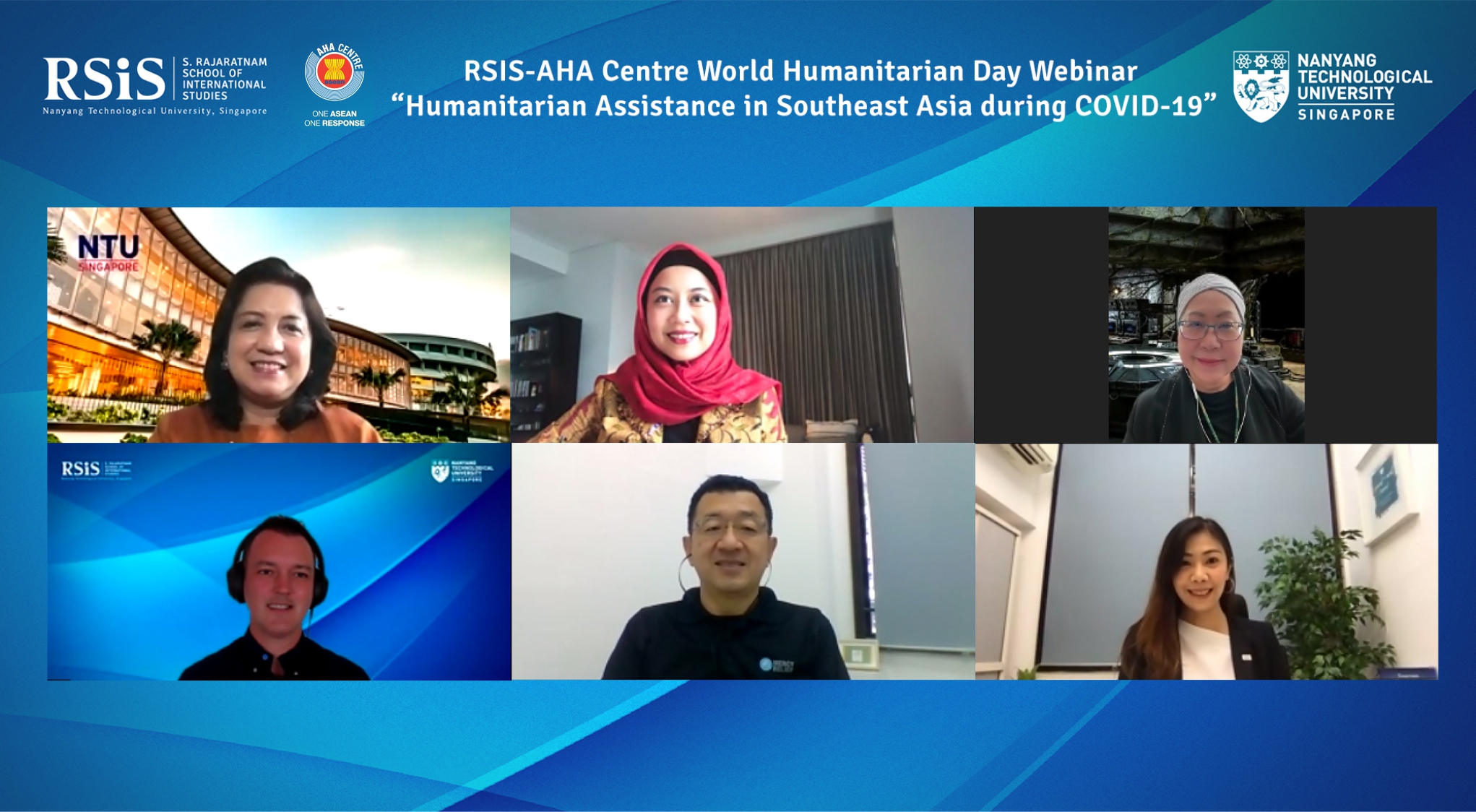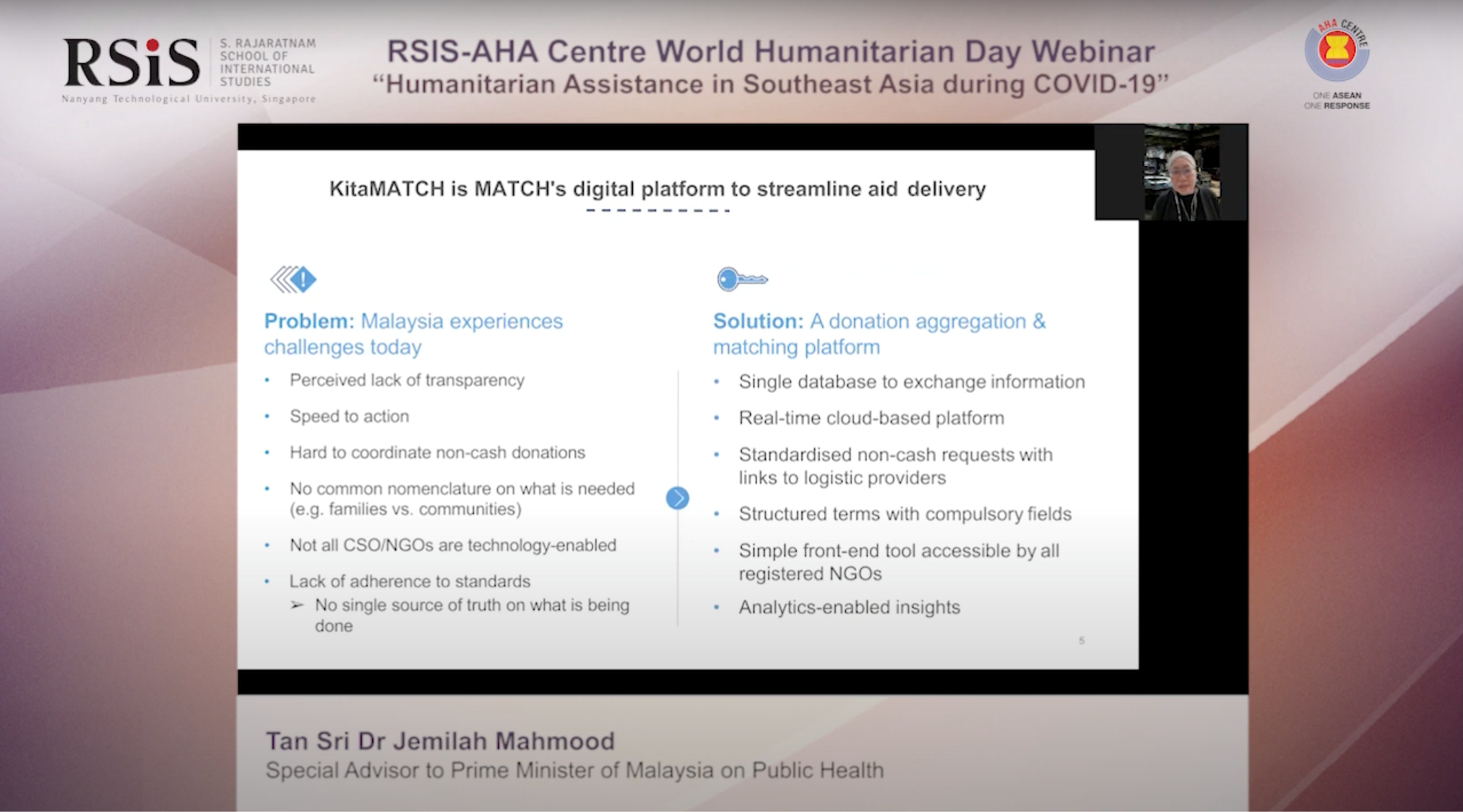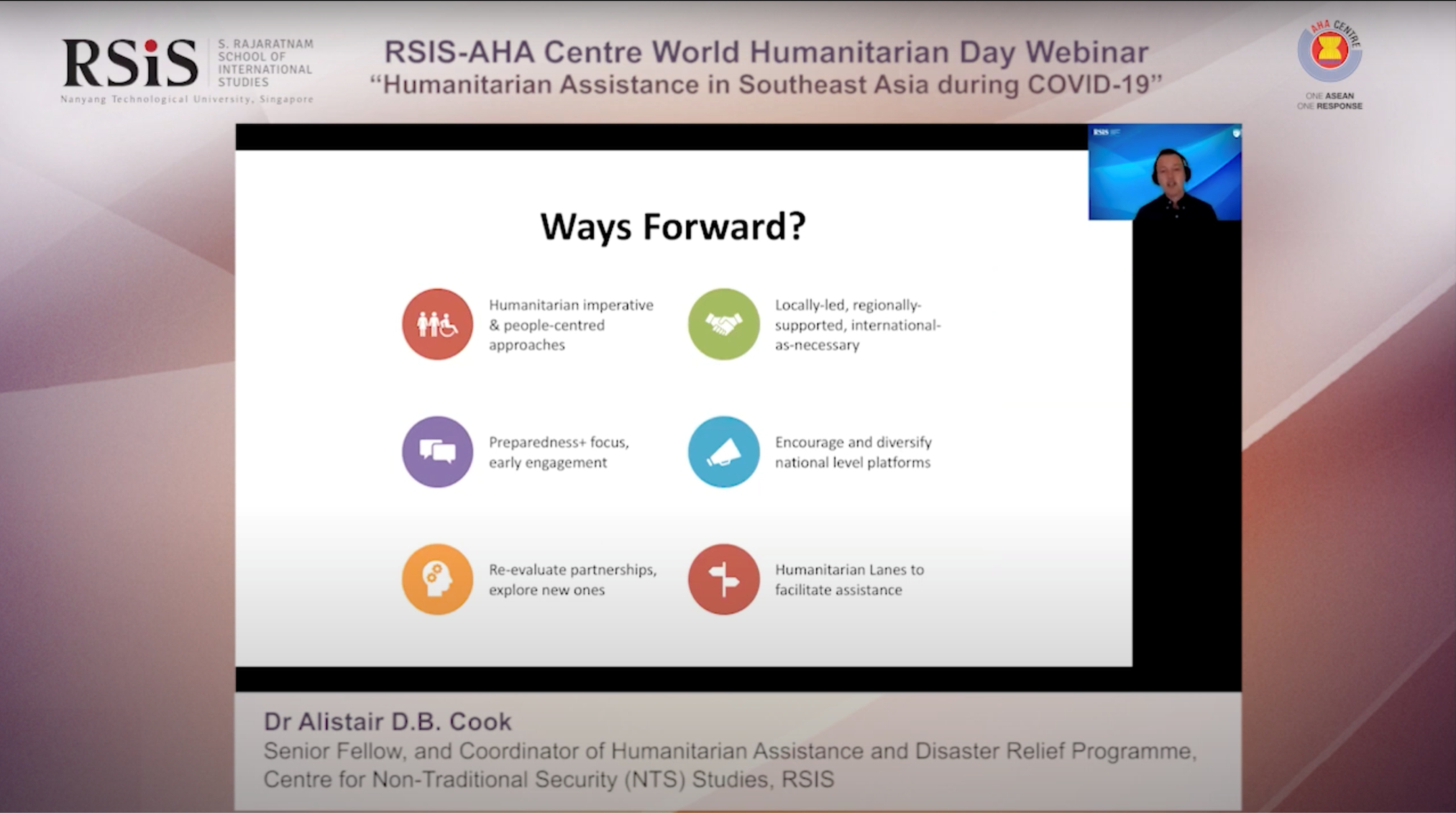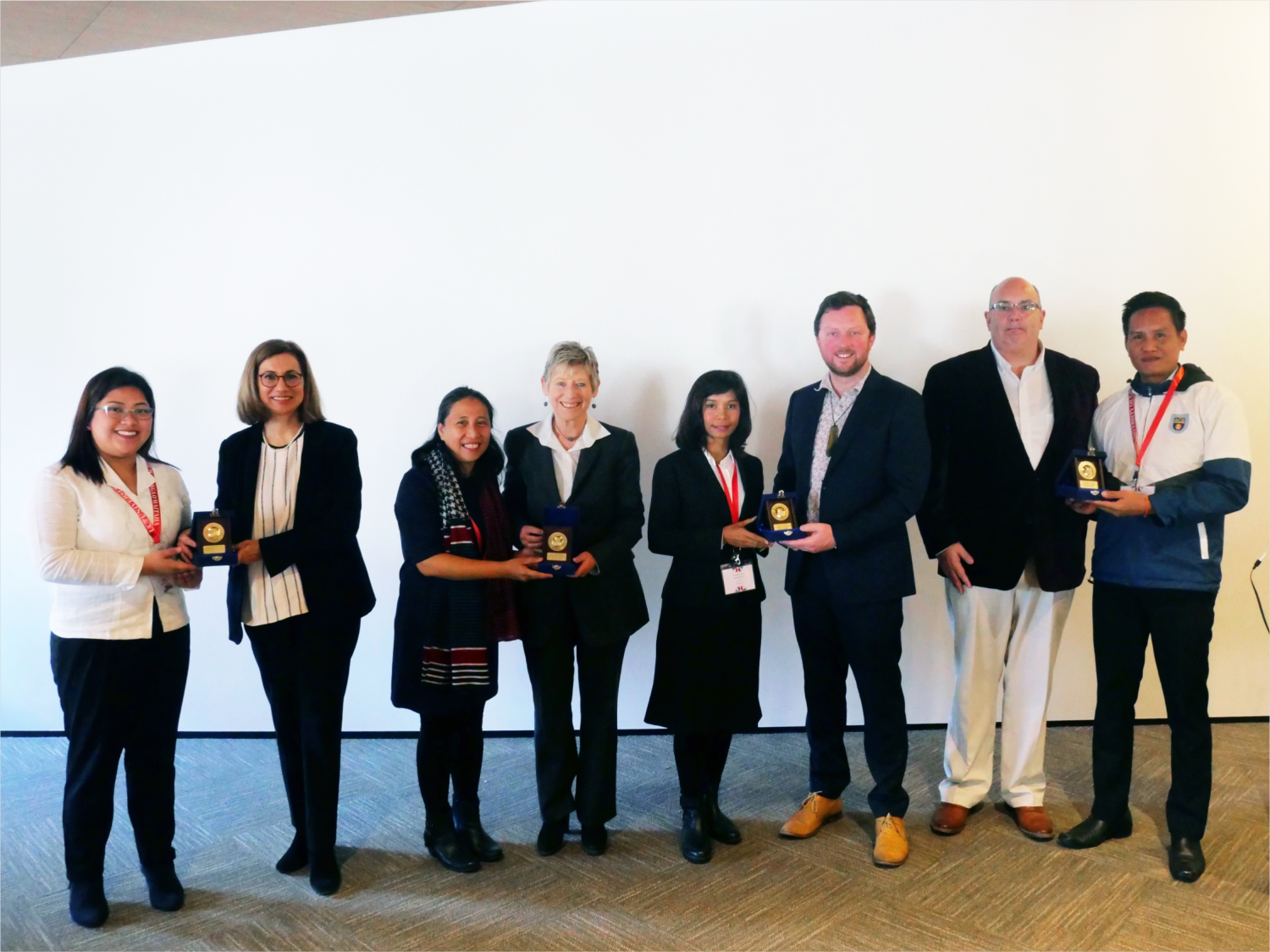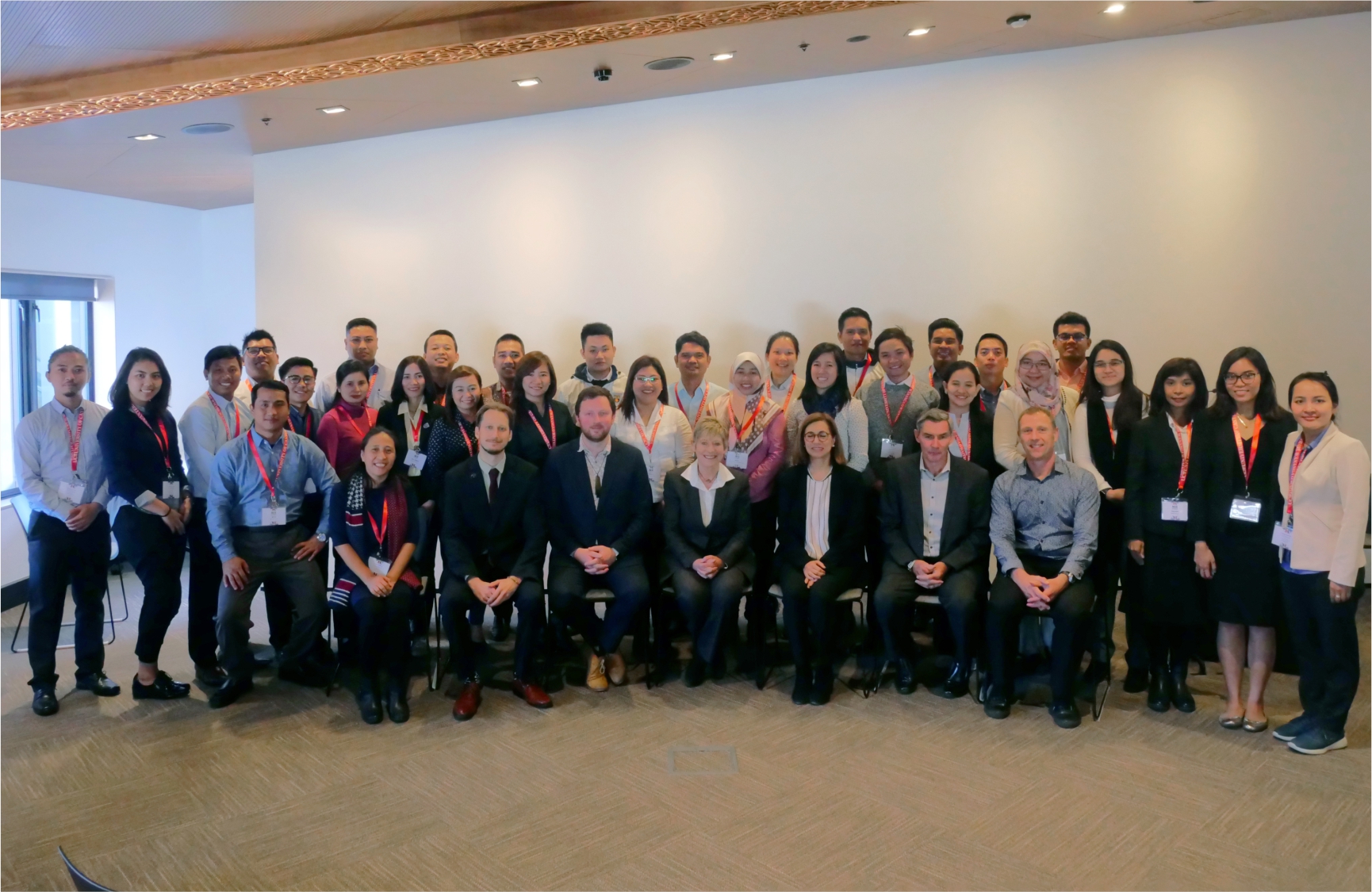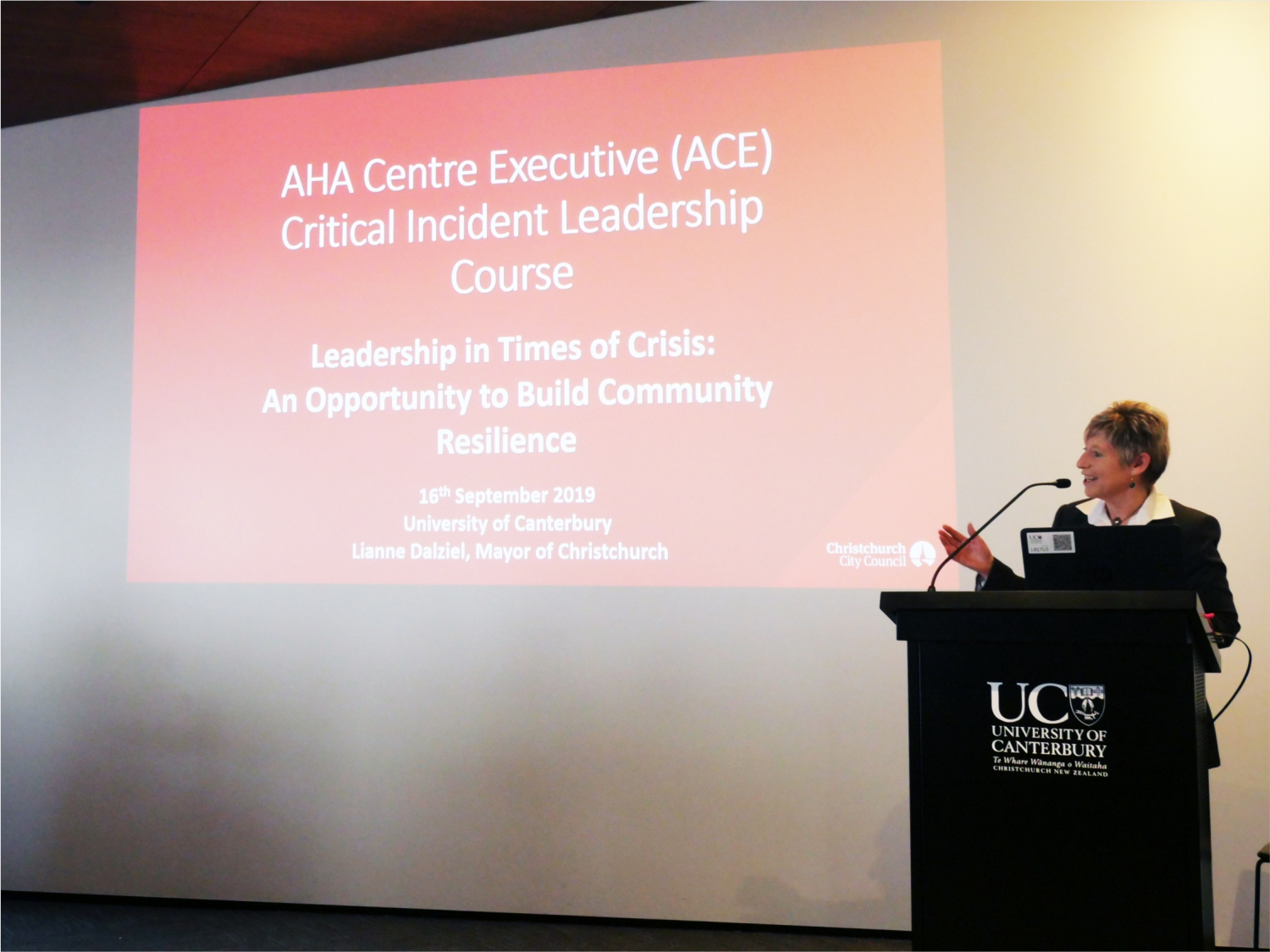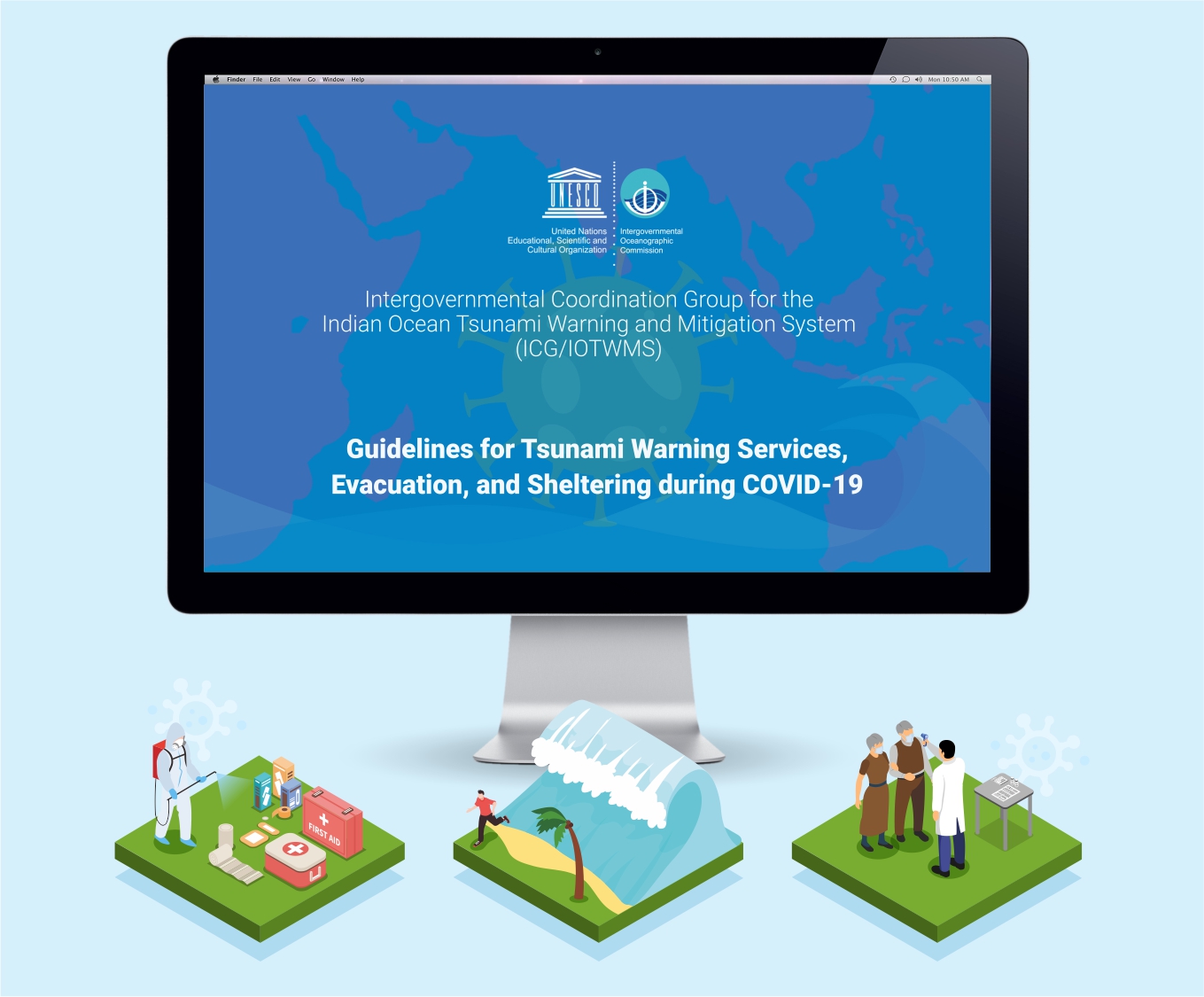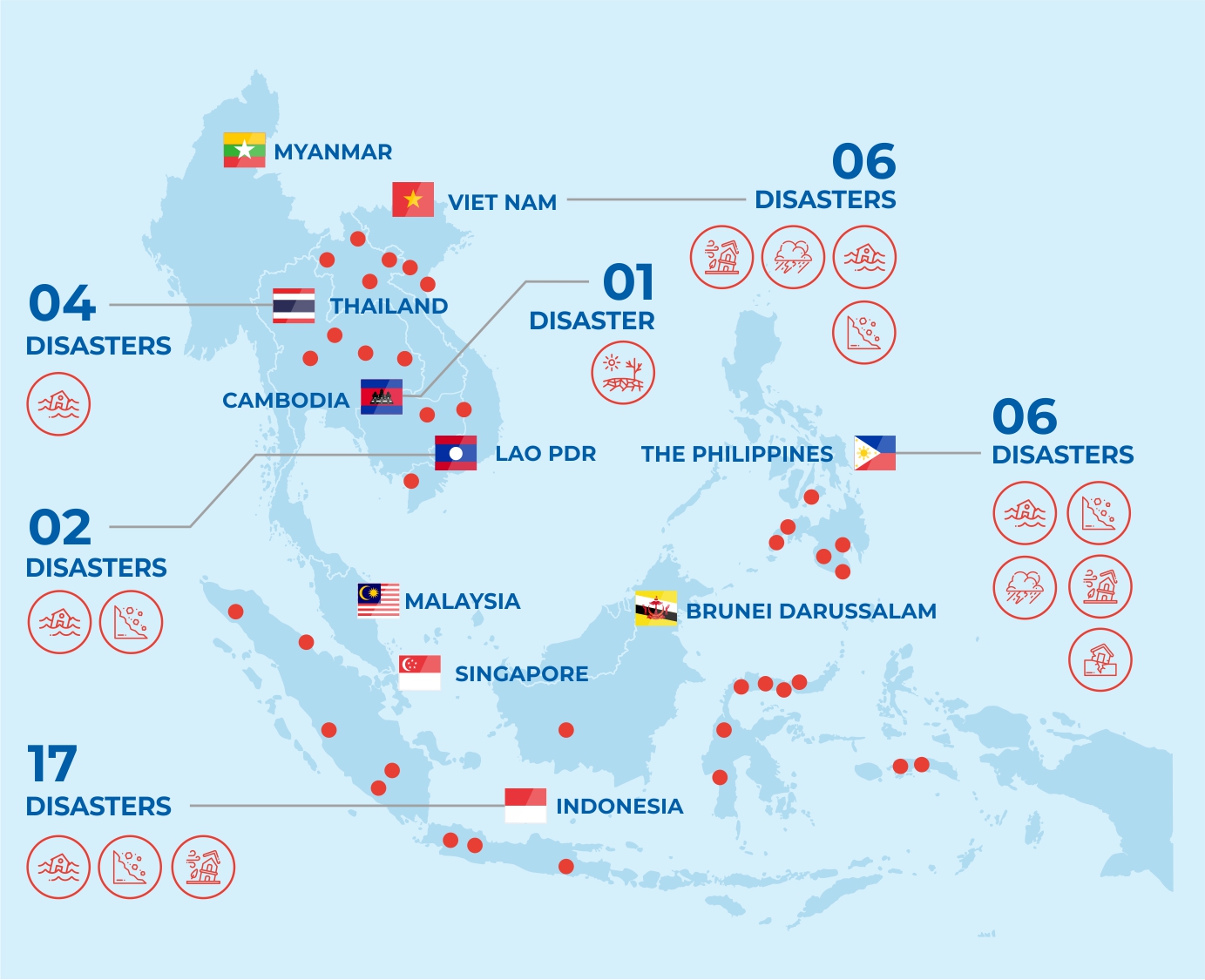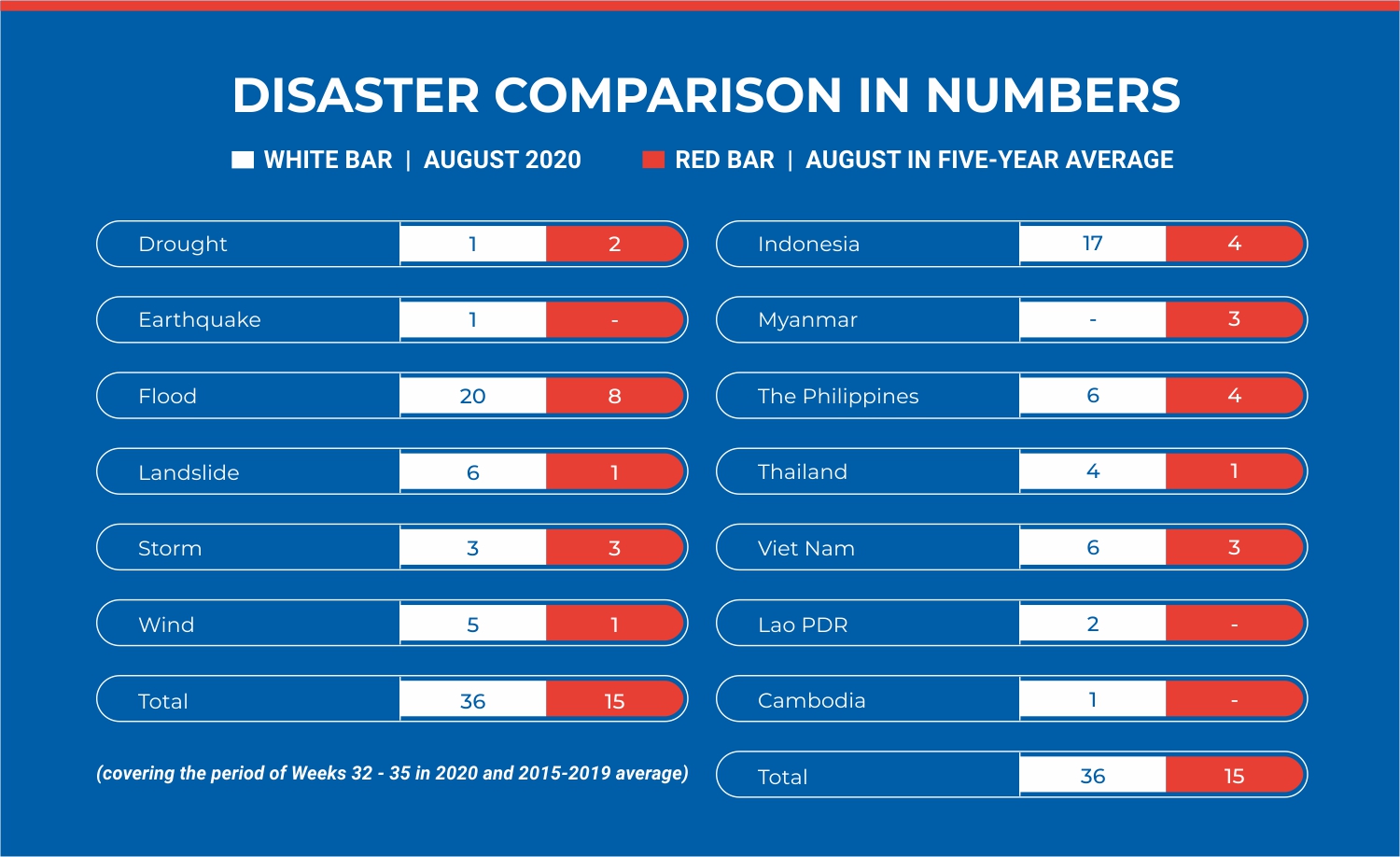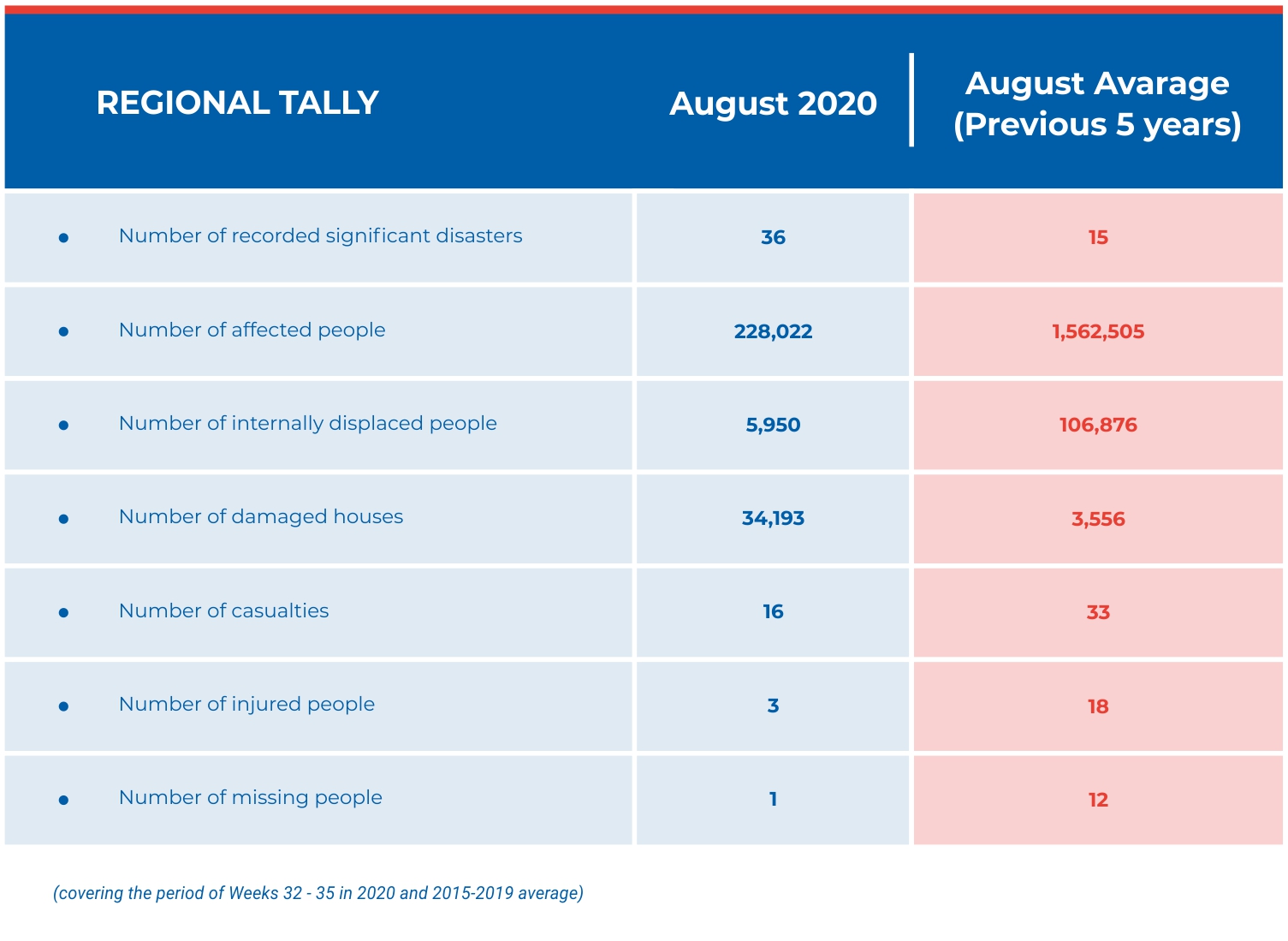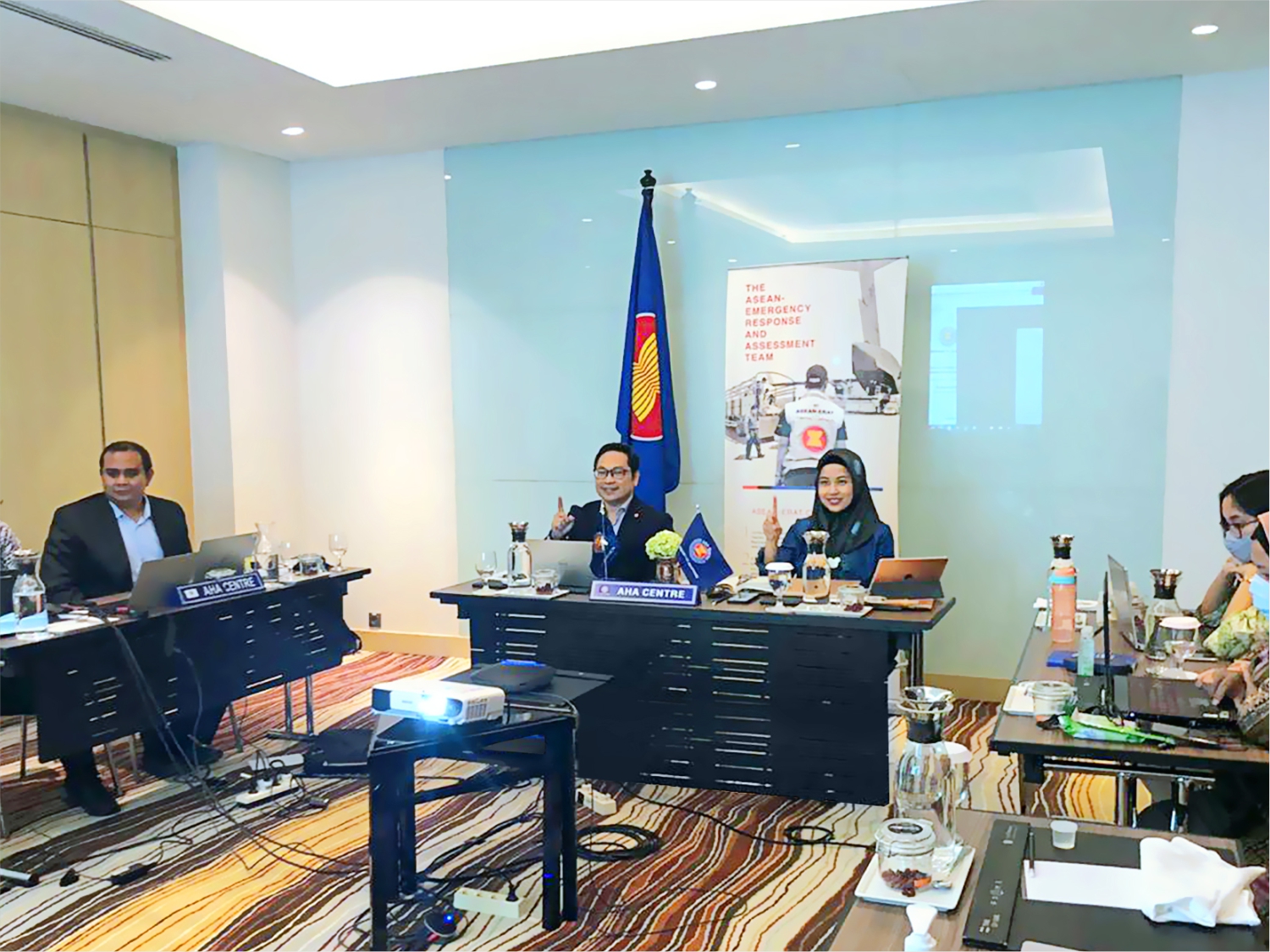Vol 65 – DISASTERS DURING A PANDEMIC: ARE COUNTRIES MORE WILLING TO ACCEPT INTERNATIONAL AID?

DISASTERS DURING A PANDEMIC:
ARE COUNTRIES MORE WILLING TO ACCEPT INTERNATIONAL AID?
This month’s Insight article comes from the AHA Centre’s own Deputy Executive Director, Arnel Capili.
What if another major earthquake triggers a tsunami somewhere along the vast coastline of Indonesia? Or a super typhoon devastates one of the many islands of the Philippines? Would these countries, or other vulnerable nations in Southeast Asia, be more willing to accept international assistance in light of the pandemic?
Before the current pandemic, we saw a shift in some of the region’s countries’ policy to implement nationally-led disaster responses – with any support from the international community based on specific priorities. This was true during the Central Sulawesi earthquake in 2018, where the Government of Indonesia clearly manifested that the response was local, and that any offers of international assistance should be in-line with identified gaps, and channeled through local partners (such as the local Red Cross, local NGOs, and local government).
This tendency of governments to temper overwhelming “love and support” can be traced back from their experience of having a secondary disaster — a ‘tsunami’ of unsolicited assistance after the 2004 Banda Aceh tsunami, and super typhoon “Haiyan” (2013). The assumption is that the donations and support teams posed increased challenges for the governments of Indonesia and the Philippines, so much so that it eclipsed the well-intentioned purpose.
So then, are countries in the region more willing to accept offers of international assistance during a disaster in the middle of COVID-19 pandemic? Let us examine possible scenarios to provide some insights, and initiate conversations about how to plan responses to natural disasters in light of the pandemic.
In the short term, countries in the region will probably remain steadfast with their preference for a more nationally-led response. Understanding that most countries in the region have very strict restrictions on movement – particularly from ‘foreigners’ who are potential carriers of the virus – cash or remote technical support will be preferred. Durable goods may be accepted on the basis of diplomatic relations. For political considerations, offers from ‘friendly’ countries may be accepted to maintain good relationships, as well as in the interest of reciprocity. Regional organisations such as ASEAN may be accorded more space to reduce international humanitarian footprint.
In the longer-term, and if the threat of the pandemic persists, there is a potential for countries in the region to reconsider this position. The policy shift will stem from the fact that government resources – including its frontline services – may be exhausted. With an economic downturn and the mounting pressure to support communities, governments may be more flexible to accept international assistance. Although still considered to be a national response, governments may extend greater flexibility allowing exemptions and greater access to the international humanitarian community.
Regardless, national authorities will carefully weigh-in on issues related to national capacity and domestic politics. For a country reeling from the effects of COVID-19, food and durable goods such as mobile storage units, health and hygiene kits, and the required logistics to move them will be prioritised. Planning and anticipation are key for issues surrounding entry and quarantine requirements, certifications of compliance to national standards for medical teams and their equipment, and special handling requirements for relief items (disinfecting at port of entry for example).
One thing is undeniable – disasters during this pandemic will redefine how we do things. It will challenge how we think about humanitarian action, not just during the pandemic, but also how this model of response can be adapted post-pandemic. The difficulties faced during the pandemic have shown us that there are other ways to provide support aside from being on the ground, and that being first to assist is not necessarily a priority. Rather, it is more a profound need for greater thinking of how the international humanitarian community could enhance and add greater value to a nationally-led response.
Written by : Arnel Capili | Photo: AHA Centre
- Published in Insight
Vol 65 – MONTHLY DISASTER REVIEW AND OUTLOOK

MONTHLY DISASTER REVIEW AND OUTLOOK
SEPTEMBER 2020 | DISASTER MONITORING & ANALYSIS
(DMA) UNIT, AHA CENTRE
GENERAL REVIEW OF SEPTEMBER 2020
A total of 45 disaster events were recorded for the month of September 2020, which 1 1/2 times higher than August 2020, and is almost four times the five-year average for September. Despite this increase, there were a range of lower numbers compared to five-year averages, including significantly less people affected, internally displaced, casualties and injuries. There were more houses damaged, however, than the average. These significant differences can be attributed to severe disaster events taking place in September 2018, including the earthquake and tsunami in Central Sulawesi, an earthquake in the Philippines, and Typhoon Mangkhut which affected the northern part of the Philippines, Malaysia, and Viet Nam. In total, said events affected about 10 million people in 2018. Additionally, 2017 saw massive droughts in Indonesia, which affected around 4 million people, and also contributes to the high five-year average figures for the month of September.
A total of 27 significant earthquakes (M≥5.0) were reported in the region for September 2020, and also ongoing volcanic activity reported for the Indonesian mountains of Anak Krakatau, Ibu, Semeru, and Dukono. While the events did not result in significant damage, they do serve as a timely reminder of the importance of geophysical hazard preparedness, particularly in tectonically active countries like Indonesia and the Philippines.
SEASONAL OUTLOOK
Southwest monsoon conditions are expected to persist throughout October 2020, before gradually transitioning into the inter-monsoon period in the latter part of the month. Inter-monsoon conditions are characterised by light and variable winds, with rainy conditions expected over most of the ASEAN region. The inter-monsoon period typically lasts for about a month before the onset of Northeast Monsoon conditions, when the northern ASEAN region enters its traditional dry season, while the southern ASEAN region experiences increased rainfall.
For the October to December period, models predict above-normal rainfall over much of the Maritime Continent (south of the equator and the Philippines) and coastal regions of Viet Nam. La Niña conditions have developed over the tropical Pacific Ocean, and most climate models predict La Niña will bring wetter-than-normal conditions over the Southeast Asia region. These are expected to persist for October through to December 2020, which may cause more torrential rains and resulting flooding across many areas.
While warmer-than-normal temperatures are expected to continue over much of the Maritime Continent for the next three months, parts of Viet Nam, Laos, Cambodia and Thailand may experience below to near-normal temperatures.
For October and November, hotspot activities in the ASEAN region are expected to remain generally subdued due to rainy weather, although isolated hotspots may be detected in some areas during brief periods of drier weather. In December 2020, a gradual increase in hotspot activities may be expected in the northern ASEAN region as it enters its traditional dry season with the onset of Northeast Monsoon.
Data Sources: ASEAN Disaster Information Network, ASEAN Specialised Meteorological Centre
Written by : Keith Paolo Landicho, Lawrence Anthony Dimailig, Aril Aditian
DISCLAIMER
Disclaimer: AHA Centre’s estimation is based on data and information shared by National Disaster Management Organisations (NDMOs) and other relevant agencies from ASEAN Member States, international organisations and news agencies. Further information on each recorded-significant disaster, description and detail of data and information are available at: http://adinet.ahacentre.org/reports.
- Published in Monthly Disaster Outlook
Vol 65 – ASEAN LAUNCHES PROJECT ON STANDARDISATION AND CERTIFICATION FOR EXPERTS IN DISASTER MANAGEMENT

IN PURSUIT OF EXCELLENCE:
ASEAN LAUNCHES PROJECT ON STANDARDISATION AND CERTIFICATION FOR EXPERTS IN DISASTER MANAGEMENT
The ASEAN Standards and Certification for Experts in Disaster Management (ASCEND) Project was developed from the challenge faced by National Disaster Management Organisations (NDMOs) of ASEAN Member States and the AHA Centre when responding on the ground to a large-scale disaster. In these circumstances, humanitarian actors engage from many different organisations, institutions, private companies, as well as individuals, to provide various kinds of support to those affected. While these stakeholders often hold the capacity to respond, there remained a challenge in identifying and validating their specific skills for coordination purposes.
On the 22nd September 2020, the ASCEND Project was officially launched through a joint launching ceremony, opened by the Secretary-General of ASEAN H.E. Dato Lim Jock Hoi, Ambassador of the Republic of Korea to ASEAN H.E. Lim Sungnam, and the AHA Centre’s Executive Director, Ms Adelina Kamal. Many ASEAN disaster management community stakeholders attended the ASCEND launching event, as well as representatives from AHA Centre donors and partners.
The ASCEND programme was developed to validate, and thus provide recognition, to specific skills and competencies held by individuals working in the disaster management sector. This certification will help the AHA Centre and ASEAN Member States to determine the skills and expertise available for both deploying or receiving support teams at times of disaster. Alongside this, competency standards can also serve as a credible reference to guide disaster management institutions and organisations when they are developing their own specific training programmes. For individuals, this certification will support their continuous learning and career progression within the disaster management sector.
From 2016-2019, led by the National Disaster Management Agency of Indonesia (BNPB) through its Competency Certification Office (LSP-PB), the first phase of the ASCEND Project developed a foundation for future efforts through the endorsement of the ASCEND Framework by the ASEAN Committee on Disaster Management. As well as the ASCEND Framework’s endorsement, the standard competencies for the first five disaster management professions were identified and provided. These professions are: Rapid Assessment; Humanitarian Logistics; Shelter Management; Emergency Operations Centre, and; Water, Sanitation and Hygiene.
After the completion of ASCEND phase one in early 2020, the AHA Centre received confirmation of generous support from the Republic of Korea through the ASEAN-Korea Cooperation Fund (AKCF). This support will allow for the ASCEND development to continue for the next three years. In implementing the ASCEND project, the AHA Centre will also collaborate with the Korean National Fire Agency (KNFA), where both parties will benefit through the exchange of knowledge and expertise, and activities including conducting a joint event.
The three years of ASCEND Project phase two implementation is aimed towards institutional and technical preparation. For institutions, the project will prepare relevant institutions that will implement the ASCEND certification process, including a Competency Body, Certifying Body and Assessment Providers. For the technical side, the project will prepare technical tools such as an ASCEND toolbox, training and certification management systems necessary to guide and document the certification process. Following the institutional and technical preparation, the project will conduct a certification assessment pilot for the first five professions, while continuing to promote and increase awareness of ASCEND throughout ASEAN target groups. This pilot activity will provide feedback for learning and iterative improvements before the ASCEND Programme is scaled-up.
This forms an exciting journey for the AHA Centre and the ASEAN Member States to ensure this initiative further contributes to the realisation of ASEAN’s goal to become a global leader in disaster management by 2025, as articulated in the ASEAN Vision 2025 on Disaster Management. The AHA Centre, through the ASCEND Project, looks forward to working closely with the Republic of Korea, NDMOs, the ASEAN community, and AHA Centre partners, in enhancing regional resilience with more competent disaster management experts available in the region.
Written by : Andrew Mandranugraha / Ririn Dwi Haryani | Photo Credit : AHA Centre
- Published in Highlight
Vol 64 – ANDREANE TAMPUBOLON

ANDREANE TAMPUBOLON
Andreane Tampubolon, or Anne as she is known to her colleagues and friends, works with the Indonesian Red Cross Restoring Family Links (RFL) team. As the head of the RFL team within the Disaster Management Unit, Anne has been engaged in the organisation for more than 10 years, providing her with a rich variety of experiences and engagements across the international disaster management sector. Anne has also contributed as a facilitator in the AHA Centre Executive (ACE) Programme, and has been deployed as an ASEAN Emergency Response and Assessment Team (ASEAN-ERAT) member to regional disasters including the 2015 Myanmar floods, the 2016 earthquake in Aceh, Indonesia, and the recent Greater Jakarta floods, also in Indonesia. Anne also holds many deployments directly as part of the Red Cross.
For this article we engaged Anne with questions on a variety of areas related to disaster management, and her responses and ideas were interesting and full of understanding.
What has been your greatest challenge in responding to disaster on a regional level?
Identifying, utilising and sharing information across language barriers is a significant challenge through all my experiences. For example, immediate responders are the ones who often have the greatest knowledge of the situation and how to handle it. However, it can be a challenge to share this knowledge from partners from other countries. In terms of challenge, I often find that we may need to have more field personnel with managerial skill. But, with many knowledge management skills available, it should also enhance the capacity of field personnel. Our field officer partners sometimes has difficulties to share their experience with a wider audience. This can have an effect on the knowledge transfer in the field and back to higher levels, as field responders often hold significant insights and experiences that should be raised with all other parties.
What challenges do you see related to disaster coordination in the region?
It can be a challenge to ensure aligned understandings between the support we are providing and the expectations of our recipients. This can be particularly heightened during disaster responses and requires strong communication, mutual understanding and personal approach.
What are some of the cross-cutting challenges you have faced?
Gender balance in teams deployed for fieldwork remains a challenge, I think. For example, I have previously been deployed in a team of 10 individuals and I was the only woman. However, I have previously been deployed in a team of four with three of those team members being women, so there is scope for better balance. This issue needs further attention in our region as it can have an impact on the work – whether we realise it or not.
With so many deployments, you are clearly used to working intensively in the field. What are your self-care tips for handling stress and pressure?
I fully believe it is best to make sure that you are able to take care of yourself before you attempt to take care of others in a disaster situation. This is a significant part of preparation for field deployment, and people have different ways of ensuring they are ready, as well as how they maintain their health in the field. I personally like to ensure I have a little downtime wherever I go and have some light entertainment to enjoy while I rest. In a technological world, having movies to watch or music to listen to is quite easy, and this is what I do to enjoy my down time when I can get some.
As you’ve been engaged in the ACE Programme, what do you see as the importance and meaning of good leadership?
Being a good leader means knowing the strengths and weakness of people that I work alongside and making sure that I do my best to identify gaps, weaknesses and room for improvement in a team. It is also important to work with people to improve people to lessen their weaknesses and increase their strengths. Being a good leader is also not just telling people what to do but working with them to achieve the goals.
So, what would you like to remind readers about in relation to the humanitarian sector?
I would remind everyone that being a humanitarian worker means you must remember to be a human. We can’t just work through systems and by protocols alone, but we must use our empathy and remember that we all are humans, and don’t forget to keep in mind to enjoy every process. There might be ups and downs in every operation. Not necessary with the good intention to help the process will then be smooth all the way. Yet manage the expectation and try the best you can to achieve the objectives accordingly
Written by : Ina Rachmawati | Photo : Private Collection
- Published in The Other Side
Vol 64 – RSIS-AHA CENTRE WORLD HUMANITARIAN DAY WEBINAR: HUMANITARIAN ASSISTANCE IN SOUTHEAST ASIA DURING COVID-19

RSIS-AHA CENTRE WORLD HUMANITARIAN DAY WEBINAR:
HUMANITARIAN ASSISTANCE IN SOUTHEAST ASIA DURING COVID-19
In commemoration of the World Humanitarian Day on 19 August 2020, the AHA Centre collaborated with the Centre for Non-Traditional Security (NTS) of the Rajaratnam School of International Studies (RSIS) to implement a webinar on Humanitarian Assistance in Southeast Asia during COVID-19.
The discussion focused on the potential dual threats of a pandemic and natural disaster. Speakers shared ideas and insights on the particular challenges faced by the humanitarian sector during the pandemic, as well as potential solutions to the challenges, and how to strengthen partnerships between relevant stakeholders.
The webinar featured a number of distinguished speakers and guests. Primarily there was Tan Sri Dr. Jemilah Mahmood, who previously served as the Under Secretary General for Partnerships at the International Federation of Red Cross and Red Crescent Societies (IFRC) and currently is the Special Advisor to the Prime Minister of Malaysia on Public Health. Next were Mr. Masahiro Ishizeki, the Head of International Programmes of Mercy Relief, and Ms. Carol Lee, Executive Director of Mercy Relief. Dr Alistair D. B. Cook is Coordinator of the Humanitarian Assistance and Disaster Relief Programme and Senior Fellow at the NTS Centre, RSIS. Prof. Mely Caballero-Anthony, Head of NTS Centre, RSIS, opened the one-hour webinar, and Ms. Adelina Kamal, the Executive Director of the AHA Centre, served as the moderator of the discussion.
All speakers raised many important points during the course of the discussion. Dr. Mahmood said that the pandemic should not be an excuse for the region to ‘take their eyes off’ the many issues facing the region, including the ongoing threat of natural disasters, climate change, refugees and irregular migration. She also highlighted the potential solutions offered by technology in mitigating the impact of the pandemic, such as one example applied in Malaysia named the “Kita Match” application.
Mr. Ishizeki shared the activities implemented by Mercy Relief in several countries in the region to mitigate the impact of the pandemic, as well as some of the learnings from the response. Key points included on ensuring accountability, as well as the logistics of managing operations spanning several countries at the same time.
Finally, Dr. Cook noted several humanitarian trends happening right now, many of which actually preceded the pandemic, but became more pronounced due to COVID-19. Examples included how the needs of the most vulnerable population often become secondary to the political security considerations, and the challenge to global cooperation as more countries turn to regional collaboration. Dr. Cook also proposed for humanitarian lane to facilitate quick transfer and distribution of humanitarian assistance during emergencies, as well as a national one stop shop in order to enhance government’s relations with local and national partners, including the private sector.
Written by : Dipo Summa | Photo : AHA Centre
- Published in AHA Centre Diary 1
Vol 64 – UNIVERSITY OF CANTERBURY

UNIVERSITY OF
CANTERBURY
The University of Canterbury and the AHA Centre have held a long and close relationship since the AHA Centre’s early years after establishment, with the university continuously sharing disaster response knowledge with ASEAN nations, particularly through its engagement with the AHA Centre Executive (ACE) Programme since 2014.
The University of Canterbury (UC) has catered to the demand for university level emergency management professional development and education since 2013. ACE Programme participants have benefited from UC’s dynamic disaster management faculty, who have been delivering short courses and qualifications, driven by their internal team’s international experience in the field of disaster management.
As part of the ACE Programme curriculum, the University of Canterbury has delivered the Critical Incident Leadership (CIL) course since the programme began in 2014. The course introduced participants to various hazards, and engaged them on the essentials of critical incident leadership competencies. In Jakarta, participants learnt about a range of hazards in New Zealand, as well as the institutional structures and policies that govern New Zealand’s disaster risk management processes.
The second phase of the CIL course is a 150-hour component delivered in various locations across New Zealand. This phase concentrates on the development of strategic thinking, proactive planning, decision-making, situational awareness, communication, coordination, and collaboration. Through field visits, the ACE Programme participants also interacted with emergency management practitioners, and experience first-hand exposure to various stakeholders – both experts and community – on how they understand their risks, prepare for, respond, and recover from disasters.
Participants were also immersed in the multicultural nature of New Zealand’s population, and see how the nation’s disaster management strategies take advantage of this diversity to strengthen their disaster risk reduction and climate adaptation efforts. The delivery of the Critical Incident Leadership Course in Jakarta and New Zealand is supported by New Zealand’s Ministry of Foreign Affairs and Trade.
Written by : Ina Rachmawati, Ferosa Arsadita | Photo : AHA Centre
- Published in Partnership
Vol 64 – TSUNAMI MITIGATION DURING THE PANDEMIC

TSUNAMI MITIGATION
DURING THE PANDEMIC
The current pandemic leaves disaster managers with new and unique challenges in preparing for – and responding to – natural disasters that may take place. With restrictions on human interaction and movement due to significant health challenges, the occurrence of a natural disaster could force large numbers of people into close proximity, with the potential to add to the disaster impact through spread of the highly contagious virus. To overcome this, planning and guidelines are required to be developed in short turnaround, and risks such as tsunami disasters require specific consideration.
The Intergovernmental Oceanographic Commission of UNESCO (IOC-UNESCO), in consultation and collaboration with expert working groups within Intergovernmental Coordination Groups (ICGs), has released regional guidelines for tsunami warning services, evacuation and sheltering during the COVID-19 pandemic. The four regional guidelines (for the Pacific Ocean, the Caribbean, the Indian Ocean, and the North-eastern Atlantic and Mediterranean) include details of regional tsunami services, that can be used by national authorities responsible for the organisation of tsunami warning and emergency response to develop their own nationally-coordinated guidelines.
These guidelines are also supported by a special national version for Indonesia, particularly due to the nation’s recent history of large tsunami events. For some Southeast Asian countries, including the Philippines and Viet Nam, the Pacific Ocean regional guidelines will provide relevant information. Meanwhile, Thailand and Myanmar can refer to the Indian Ocean regional guidelines. Additionally, these guidelines can also be applied to other coastal hazards such as storm surges and flash flooding.
When the National Tsunami Warning Centre (NTWC) and/or a National Disaster Management Organisation (NDMO) issues a tsunami warning, the desired action for the public is to follow the advice of the authorities, including evacuation from identified at-risk locations as required. It is important to highlight that human life is the priority when tsunami evacuations are required, regardless of COVID-19 stay-at-home orders and physical distancing protocol. Of course, in a state of evacuation such protocols may not be practical. Regardless, handling any resultant COVID-19 infections must be done immediately following an evacuation, to minimise the risk or large-scale infection. Communities must also be aware of COVID-19 safety protocols and any requirement for physical distancing when sheltering at an evacuation site. In addition, a personal or family emergency backpack should be augmented with disposable tissues, alcohol-based hand sanitiser, disinfectant wipes, and possibly face masks, in consideration of the heightened sanitation and hygiene requirements due to the COVID-19 virus.
Written by : Shahasrakiranna | Source : Intergovernmental Oceanographic Commission
- Published in Insight
Vol 64 – MONTHLY DISASTER REVIEW AND OUTLOOK

MONTHLY DISASTER REVIEW AND OUTLOOK
AUGUST 2020 | DISASTER MONITORING & ANALYSIS
(DMA) UNIT, AHA CENTRE
GENERAL REVIEW OF AUGUST 2020
A total of 36 disaster events were recorded for the month of August 2020, which is the same number recorded for the previous month, and similar to the amount recorded for August of 2019. This number was more than twice as high as the August five-year average, however, the figures of affected people, internally displaced, casualties, injuries, and missing persons for August 2020 were all significantly lower than their respective five-year averages. In contrast, the number of damaged houses for August 2020 was 10 times higher than the five-year average. A little over half of the total recorded disasters for the month were flooding events, which struck regions throughout Lao PDR, the Philippines, Thailand, and Viet Nam, as well as significant numbers from Indonesia. This may be attributed to a 200mm increase in precipitation amounts for August 2020 compared to the five-year average, with especially large amounts of rainfall in Indonesia’s Sulawesi, Maluku, and Western Kalimantan, according to the Climate Hazards Group InfraRed Precipitation with Station data (CHIRPS). CHIRPS assimilates satellite imagery with in-situ data to create better approximations and more reliable precipitation distribution datasets. This data also showed precipitation deficits of at most -200 mm from the five-year average over Cambodia, Lao PDR, the coasts of Myanmar, northern Philippines and northern and central Viet Nam.
Notably, the effect of Tropical Storm (TS) SINLAKU was largely felt in the Northern and Northeastern regions of Thailand. TS SINLAKU’s impact on Thailand (during week 32) affected 111,190 persons, which was almost 50% of the total number of people affected for the region throughout the whole of August.
There were a total of 32 significant earthquakes (M≥5.0) reported in the region for August 2020, and there was heightened volcanic activity reported for Mt. Sinabung in Indonesia that exposed approximately 15,000 people to adverse impacts. Volcanic activity was also reported for Kerinci, Semeru, Ibu, and Dukono mountains in Indonesia, however the activity caused minimal damage for the surrounding areas. Meanwhile, a magnitude 6.6 earthquake in Masbate, Philippines resulted in some casualties on August 19.
SEASONAL OUTLOOK
The Southwest Monsoon conditions that have been in effect since late May are expected to continue into September 2020. However, there will be a gradual transition to inter-monsoon conditions (between monsoon seasons) during the latter part of October. This inter-monsoon period is characterised by increased shower activities, so a heightened frequency of hydrological and meteorological disasters can be expected.
The ASEAN Specialised Meteorological Centre (ASMC) predicts above-average rainfall over most parts of the southern ASEAN region, as well as the coastal regions of Cambodia, Myanmar, Thailand, and Viet Nam, serving as an early warning for those Member States. ASMC’s climate models predict La Niña conditions from September 2020, which is typically associated with wetter-than-normal conditions over the Southeast Asia region.
While above-normal rainfall is predicted in the southern ASEAN region, occasional periods of dry weather could lead to escalated hotspot activities especially in vulnerable areas in Sumatra and Kalimantan in Indonesia. This could lead to increased risk of land and forest fires and transboundary haze in the southern ASEAN region. In the northern ASEAN region, however, it is expected to be largely subdued due to the prevalence of rainy conditions.
Data Sources: ASEAN Disaster Information Network, ASEAN Specialised Meteorological Centre
Written by : Keith Paolo Landicho, Lawrence Anthony Dimailig, Aril Aditian
DISCLAIMER
Disclaimer: AHA Centre’s estimation is based on data and information shared by National Disaster Management Organisations (NDMOs) and other relevant agencies from ASEAN Member States, international organisations and news agencies. Further information on each recorded-significant disaster, description and detail of data and information are available at: http://adinet.ahacentre.org/reports.
- Published in Monthly Disaster Outlook
Vol 64 – DISCUSSING THE OF THE AHA CENTRE FUTURE DIRECTION

12th GB MEETING:
DISCUSSING THE OF THE AHA CENTRE FUTURE DIRECTION
Held two times each year, this instalment of the Governing Board of the AHA Centre was originally slated to be held during April 2020. Due to the ongoing pandemic, the 12th Meeting of the Governing Board of the AHA Centre was re-scheduled into August 2020, and engaged the 10 National Disaster Management Organisations from ASEAN Member States to meet in an online environment.
With the situation meaning that the Philippines hosting a physical face-to-face meeting was no longer possible, the Governing Board agreed to implement it in an online fashion, making this the first time this key event has been undertaken online. The meeting was held back-to-back along with the 36th Meeting of the ASEAN Committee on Disaster Management (ACDM), and the 13th Meeting of the Joint Task Force (JTF) to Promote Synergy with Other Relevant ASEAN Bodies on Humanitarian Assistance and Disaster Relief (HADR). These events all took place from the 11 – 12 August 2020, with the 12th Meeting of the Governing Board taking place in the afternoon of August 12.
Similar to regular meetings of the Governing Board, the AHA Centre usually uses the forum to update the Governing Board of its activities spanning the period from the last such meeting, which in this case took place in October 2019. This year’s meeting was quite unique, not only because of the pandemic context, but also as 2020 forms the end of the AHA Centre’s 5-year work plan. The AHA Centre used this momentum to continue discussions on rethinking the vision and mission of the AHA Centre for the coming five years and beyond. The timing of the meeting was also in-sync with the Governing Board members (in their role as the ACDM) developing a new cycle of the AADMER Work Programme for 2021-2025.
In addition to discussions on rethinking the AHA Centre’s vision and mission, the meeting was also utilised to launch three key AHA Centre publications. The first was the AHA Centre Annual Report 2019, that focused on the theme of ‘Unfolding Future’, with the report highlighting the focus of the AHA Centre in 2019 towards continuing its expansion and development for the future. The second publication was the After-Action Review of the AHA Centre emergency response operations in 2018 – a year in which the AHA Centre responded to 7 back-to-back disaster events. Finally, the AHA Centre launched the second edition of the ASEAN Risk Monitor and Disaster Management Review (ARMOR), that focuses on the theme of Climate Emergencies. Named “Time is Running Out: Why ASEAN Must Act Now against Climate Emergencies”, the journal uses both historical data and the most up-to-date information, trends, and risk profiles of the ASEAN countries with regards to climate change and disasters.
The 12th Meeting of the Governing Board of the AHA Centre was officially closed by Undersecretary Ricardo B. Jalad, the Administrator of the Office of Civil Defense of the Philippines, who was serving as the Chairperson of the Governing Board. The 13th Meeting of the Governing is scheduled to be held at the end of November 2020, and will be most likely be once again held in an online environment.
Written by : Dipo Summa | Photo Credit : AHA Centre
- Published in Highlight
- 1
- 2

